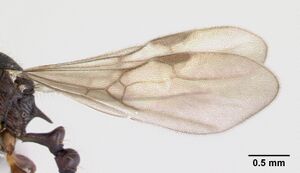Vitsika miranda
| Vitsika miranda | |
|---|---|

| |
| Scientific classification | |
| Kingdom: | Animalia |
| Phylum: | Arthropoda |
| Class: | Insecta |
| Order: | Hymenoptera |
| Family: | Formicidae |
| Subfamily: | Myrmicinae |
| Tribe: | Crematogastrini |
| Genus: | Vitsika |
| Species: | V. miranda |
| Binomial name | |
| Vitsika miranda Bolton & Fisher, 2014 | |
From the material available this species appears to be mostly found above ground level. Specimens have been found on low vegetation, in a dead bamboo stem, in a dead twig above the ground, and in a rotted pocket on a standing tree. A single worker has been retrieved from a pitfall trap, and an alate queen was found walking on the ground.
Identification
Bolton and Fisher (2014) - V. miranda is very closely related to Vitsika obscura, and both resemble the yellow Vitsika astuta. However, astuta has long, fine, suberect setae on the dorsal (outer) surface of the metatibia, the longest of which are almost as long as the maximum tibial width, and lacks, or at most has only vestiges of, transverse costulae on the propodeal declivity. By contrast, the suberect setae in both miranda and obscura are stubbly and distinctly shorter than the maximum tibial width, and the transverse costulae of the propodeal decivity are conspicuous.
Keys including this Species
Distribution
Endemic to Madagascar.
Latitudinal Distribution Pattern
Latitudinal Range: -23.4144° to -23.4635°.
| North Temperate |
North Subtropical |
Tropical | South Subtropical |
South Temperate |
- Source: AntMaps
Distribution based on Regional Taxon Lists
Malagasy Region: Madagascar (type locality).
Distribution based on AntMaps
Distribution based on AntWeb specimens
Check data from AntWeb
Countries Occupied
| Number of countries occupied by this species based on AntWiki Regional Taxon Lists. In general, fewer countries occupied indicates a narrower range, while more countries indicates a more widespread species. |

|
Estimated Abundance
| Relative abundance based on number of AntMaps records per species (this species within the purple bar). Fewer records (to the left) indicates a less abundant/encountered species while more records (to the right) indicates more abundant/encountered species. |

|
Biology
Castes
Males have yet to be collected.
Queen
Images from AntWeb

| |
| Queen (alate/dealate). Specimen code casent0003876. Photographer Erin Prado, uploaded by California Academy of Sciences. | Owned by CAS, San Francisco, CA, USA. |
Nomenclature
The following information is derived from Barry Bolton's Online Catalogue of the Ants of the World.
- miranda. Vitsika miranda Bolton & Fisher, 2014: 86, figs. 105-107, Map 157 (w.q.) MADAGASCAR.
Unless otherwise noted the text for the remainder of this section is reported from the publication that includes the original description.
Description
Worker
(holotype in parentheses). TL 3.5–4.0 (3.7), HL 0.74–0.84 (0.83), HW 0.62–0.73 (0.70), CI 84–87 (84), SL 0.54–0.63 (0.62), SI 85–89 (89), PW 0.47–0.56 (0.54), WL 0.94–1.08 (1.06) (7 measured).
Eye with 8–9 rows of ommatidia, and with 9–11 ommatidia in the longest row; EL 0.17–0.22 (EL/HW 0.27–0.30). MfL 0.68–0.78 (MfL/HW 1.06–1.09). Antennal scape about the same shade as the head capsule, or at most only fractionally lighter. In profile, the dorsal outline of the propodeum shallowly convex to the upper base of the propodeal spine, without a distinct peak in its outline posterior to the mesonotal-propodeal junction. Propodeal declivity with distinct transverse costulae. Diameter of annulus of propodeal spiracle equal to, or only slightly less than, the thickness of the propodeal spine at its midlength. Petiole node in profile highest at the anterodorsal angle and usually with a poorly defined, short, dorsal surface that rounds evenly into the posterior face. In posterior view the dorsal margin of the petiole node evenly, shallowly convex, or may be almost flat medially. Sculpture of petiole node weak to vestigial laterally; posterior surface of petiole node mostly smooth, but with a narrow punculate band immediately above the foramen. Height of petiole node in posterior view (from midpoint of the dorsal margin of the foramen to the apex) 0.85–0.92 × its maximum width. In dorsal view postpetiole 1.23–1.31 × broader than long; maximum width of postpetiole ca 1.00–1.15 × the length of a propodeal spine; maximum width of postpetiole 0.96–1.06 × the distance between the apices of the propodeal spines. Postpetiole node in profile relatively short and high, its dorsum distinctly convex; the length of the node in profile is visibly greater than the height of the segment. Dorsum of postpetiole node usually entirely smooth, but vestigial remnants of superficial punctulae sometimes remain. The main suberect setae on the dorsal (outer) surface of the metatibia are all about the same length, and are distinctly shorter than the maximum tibial width. Full adult colour blackish brown to almost black.
Queen
(gyne). Only alates known. HL 0.89–0.90, HW 0.75–0.79, CI 84–88, SL 0.63–0.65, SI 82–84, PW 0.65–0.68, mesoscutum maximum length 0.60, mesosocutum maximum width 0.60–0.62, WL 1.24–1.28, MfL 0.80–0.82 (2 measured). Ocelli conspicuous. Mesosoma normal for alates, with a full complement of flight sclerites, wing articulation present, and mesopleuron with a transverse sulcus.
Type Material
Holotype worker, Madagascar: R.S. Kalambatritra [Prov. Toliara], Betanana, 08.ii.2002, 23.4144°S, 46.4590°E, 1360 m., montane rainforest, BLF 21480, CASENT0147524 (B.L. Fisher et al.) (California Academy of Sciences). Paratypes. 1 worker with same data as holotype but BLF 21466, CASENT0148648; 1 worker R.S. Kalambatritra, Ampanihy, 1270 m., 23.4635°S, 46.4631°E, 10.ii.2009, montane rainforest, BLF 21743, CASENT0147063 (B.L. Fisher et al.); 1 worker and 1 dealate queen, as last but 1269m., 23.46300°S, 46.47057°E, 10.ii.2009, BLF 21665, CASENT0149989 (B.L. Fisher et al.) (CASC).
References
- Bolton, B. & Fisher, B.L. 2014. The Madagascan endemic myrmicine ants related to Eutetramorium (Hymenoptera: Formicidae): taxonomy of the genera Eutetramorium Emery, Malagidris nom. n., Myrmisaraka gen. n., Royidris gen. n., and Vitsika gen. n. Zootaxa 3791:1–99. doi:10.11646/zootaxa.3791.1.1

